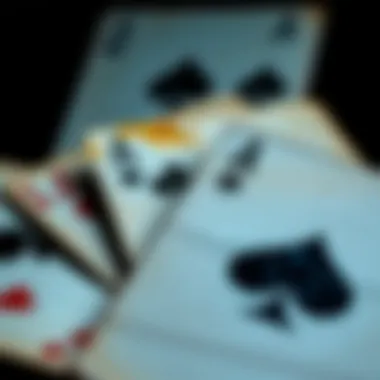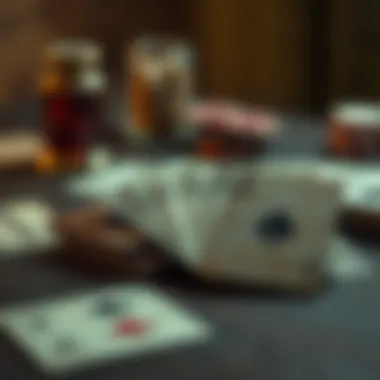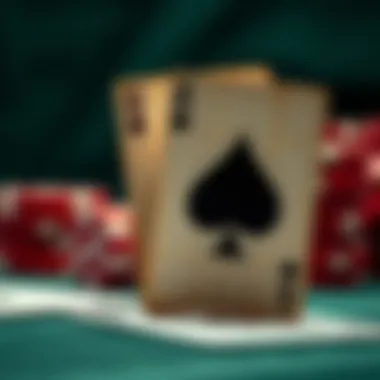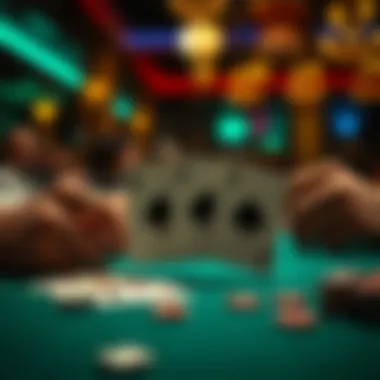The Cultural Impact of Faded Spade Cards in Gambling


Intro
Faded spade cards, often seen as mere remnants of an intense game night, hold stories that transcend their stained surfaces. In a culture rich with tradition, the way these cards age offers insights not only into the passage of time but also into the players themselves. There's a tangible connection between the tactile experience of these worn decks and the emotions they evoke.
Poker nights, crowded casinos, or casual family games—wherever cards are dealt, faded spades can signal something deeper. They carry nostalgia, a hint of yesterday’s excitement, and sometimes the weight of losses—both monetary and personal. Players often find themselves drawn toward well-worn cards, recognizing that their imperfections reflect shared journeys through the ruthless arena of gambling.
This exploration into faded spade cards isn’t just about objects; it’s about reveling in their significance within the gambling community. How does the experience of handling these cards alter one's approach to strategy? What narratives do these dulled spades tell about the moments they witnessed? Through this article, we shall delve into the strategies of gameplay influenced by the cards we use, delve deep into gambling fundamentals that arm players with knowledge, and uncover the cultural connotations that linger long after the last hand is played.
Preamble to Faded Spade Cards
When delving into the realm of gambling, one might easily gloss over the subtle yet significant role played by faded spade cards. This article seeks to unearth the layers of meaning behind these seemingly mundane objects, urging readers to appreciate their aesthetic and cultural implications. Understanding faded spade cards not only reveals their uniqueness but also enhances the overall gambling experience, fostering a deeper connection between players and their tools of the trade.
Defining Faded Spade Cards
Faded spade cards are worn-out playing cards that carry a certain charm, primarily characterized by their lost pigmentation and the gentle fraying of edges. These cards may carry marks or creases from intense gameplay, which tell a story in themselves. However, they are not just any age-worn cards; they possess qualities that elevate them beyond mere playing tools. Faded spades often symbolize the spirit of the game, reflecting the journey of seasoned gamblers who have faced countless rounds at the table. Consequently, defining faded spade cards means recognizing them as a blend of utility, history, and sentiment.
Historical Context of Card Games
The history of card games stretches back centuries, deeply interwoven with the fabric of human interaction and entertainment. Card games were first believed to emerge in China during the Tang dynasty, around the 9th century, eventually filtering through the Middle East and Europe by the late 14th century. As these games evolved, so did the evolution of the cards themselves.
Over the years, cards have transitioned from elaborate hand-painted sets to mass-produced decks that we see today. However, the essence of the play remains unchanged. In every shuffle and every draw, there exists a rich tapestry of narratives and cultures that have shaped the way we perceive games of chance. Faded spades, in this context, serve as a tangible connection to the past, evoking nostalgia for the countless hands that have played before. It’s within this historical backdrop that the allure of faded cards becomes significantly illuminated.
"Every card has a tale, much like the card players themselves—imbued with secrets and memories, waiting to be shared in the flick of a wrist."
In light of this, acknowledging the historical context of card games unveils an often overlooked aspect of gambling culture. It may seem trivial at first glance, but understanding where these faded cards come from adds a layer of depth to the gambling experience, inviting players to not just engage in a game, but to participate in a lineage.
These nuanced qualities of faded spade cards beckon both casual players and serious strategists alike to explore their significance more thoroughly. In the course of this article, we will uncover not just the aesthetic appeal of these cards, but also the strategic and cultural connotations that accompany their use within gambling communities.
The Aesthetic Appeal of Faded Cards
The allure of faded cards transcends mere play; it invites a deeper conversation about beauty in decay and the stories they embody. In the world of gambling, where the glimmer of freshly minted chips can be enticing, faded spade cards foster a unique connection to tradition and nostalgia. The aesthetic appeal of these aging tools reveals a sensory experience that resonates with players on multiple levels, crafting an atmosphere steeped in emotion and history.
Simply put, they tell tales of countless games played, adversaries faced, and moments cherished. The faded edges and softened surfaces are more than just wear and tear; they are badges of honor earned through endless hours of strategy and chance.
Beyond their visual charm, faded spade cards evoke a practical consideration in gameplay strategy. More seasoned players appreciate the subtle variations in card appearance, which can inform their tactical decisions. This multi-layered appeal highlights the importance of understanding and appreciating the aesthetic significance of faded spade cards in gambling culture.


Visual Characteristics of Faded Spades
Faded spade cards possess distinct visual qualities that set them apart from their pristine counterparts. The gradual process of aging can manifest in several ways such as:
- Color Deterioration: The vibrant colors fade into muted tones, often giving way to a soft palette that resonates with a feeling of warmth and familiarity.
- Texture Changes: The original glossy finish may wear down, leaving a tactile experience that is both comforting and engaging. Rubbing fingers over a faded card can stimulate memories of past games and victories.
- Pattern Distortion: Over time, the intricate designs may become less defined, subtly shifting the visual narrative that players grow to recognize.
These characteristics don’t merely contribute to the aesthetic; they also create a unique psychology for the players. A card that’s seen its fair share of action comes with a narrative that might sway a player’s strategy, inviting them to forge a bond with it.
The Psychology of Aging and Nostalgia
Aging is not just about physical degradation; it intertwines with human emotions in ways that are profound. For many, faded cards evoke nostalgia—a powerful feeling of longing for something lost yet cherished. The connection players feel toward their faded spade cards is steeped in personal history, shedding light on how memory operates in the context of gambling.
Each crease and scratch tells a story, reminding players of the people they’ve met, the rivalries they’ve faced, and the lessons learned while navigating the complex dynamics of games. This emotional attachment can intensify performance, as players might find themselves tapping into their past experiences during critical moments.
It is significant to note that the psychology of nostalgia does not simply reside in the realm of personal experience. It’s shared across communities—players gather, reminisce about games gone by, and pass down tales enriched with the emotions tied to these aged cards.
The aesthetic appeal of faded spade cards thus encapsulates more than a visual charm; it serves as a bridge between the past and present, inviting players to embrace the stories etched within each card, enriching their gambling experience.
Impact on Gameplay and Strategy
The interplay between faded spade cards and gameplay strategy is like a finely tuned instrument—each note contributes to the overall symphony of the gaming experience. When players sit down at a table, the condition of their cards can have implications that reach far beyond mere aesthetics. Faded cards, adorned with scuffs and worn edges, often carry a narrative of countless games played, and this history can color the perceptions and strategies of seasoned players.
One key element to consider is the psychological effect that these aged cards have on both players and their opponents. The tactile essence of a worn deck, the crinkle of the card when shuffled, can invoke feelings of nostalgia and tradition. These elements often play a subtle yet significant role in how players perceive risk, making the discussion of faded cards crucial in understanding their impact on gameplay.
Perception of Faded Cards Among Players
The perception of aged cards can vary remarkably among players. For some, faded spades exude character and experience, as they reflect moments of high stakes and nail-biting tension. A player wielding a deck that shows signs of wear might be viewed as more experienced, adding an intangible aura around the game. On the other hand, some see worn cards as a disadvantage, believing that their faded appearances can mislead them about the integrity of gameplay. Here, the visual indicators of age might create biases that can be detrimental in high-stakes situations.
Furthermore, as players engage with stacked decks that tell a story of use, they may also form strategies around the perception of these cards. The anticipation built from having a well-worn spade can make players feel more connected to the game, like they belong to a narrative larger than themselves.
Strategic Use of Aged Cards
To leverage the unique qualities of faded spade cards, players often delve into complex strategies that play on both the psychology of their opponents and the intrinsic properties of the cards themselves.
Bluffing Techniques


Bluffing with faded cards can turn the tide of a game. The main aspect of bluffing with worn cards is the psychological warfare it initiates. An opponent might misread faded cards as signaling weakness or uncertainty, inadvertently giving the bluffing player an edge. The key characteristic here is the ability to project confidence while maintaining an air of ambiguity, wherein the faded appearance can work both for and against a player's intentions.
The unique feature of using aged cards for bluffing is that they can act as a double-edged sword. While they may add credibility to a player's bluff due to an aura of 'all-in' authenticity, they can also lead to misjudgments if the player overextends their strategy. This tactic's effectiveness hinges upon a clear reading of the table, making it beneficial for those with acute observation skills.
Reading Opponents
When it comes to reading opponents, the unique shadings of faded cards can provide significant insights into the psychological profiles of other players. The irregularities and wear patterns of a deck might signal the predicted behavior of opponents, as these marks can create unspoken tells or indicators of experience levels.
A key characteristic of this strategy is that it allows players to gauge how opponents react to faded cards—do they hesitate, do they play with caution, or do they embrace the challenge? This dynamic creates a layer of strategy that can be pivotal in high-stakes games.
The advantage of cultivating these reading skills lies in the deeper understanding of an opponent's psychology, as well as the strategic adjustment of one's gameplay in reaction to perceived hesitations or bravado influenced by the cards at hand. However, this strategy requires acute attention and the ability to handle distractions, such as the emotional weight that comes with faded cards.
In summary, understanding the impact of faded spade cards on gameplay and strategy is integral in navigating the nuances of card culture in gambling. It enriches the player experience and encourages a deeper appreciation for the subtle art of card play.
Cultural Significance in Gambling Communities
The presence of faded spade cards within gambling communities is more than just an aesthetic detail; they weave themselves into the fabric of lore and tradition in various gambling settings. Amateur players and professionals alike often reflect on the stories behind their decks, sharing tales of memorable games and pivotal moments that have occurred with these cards in hand. Their faded appearance can evoke memories, making them almost akin to family heirlooms passed down through generations.
The cultural resonance of these cards is significant, extending beyond individual players to the communities they belong to. Faded spade cards often symbolize a shared history and bonds among players. They carry a story, acting as vessels for the joy, defeat, and camaraderie experienced at the table. The very act of using aged cards can transform a simple game night into a gathering steeped in nostalgia, encouraging conversations that might not arise otherwise.
Faded Spades in Popular Media
Faded spade cards have not gone unnoticed in popular media, where they often appear in films and literature, serving as a metaphor for life’s uncertainties. They can be spotted in various poker scenes, from underground games in dimly lit basements to high-stakes tournaments. One movie that prominently features such cards is "Rounders," where the protagonist encounters the emotional weight of specific hands played over years of friendship and rivalry.
These visual elements help reinforce the idea that faded cards are a crucial part of narrative depth, enhancing stories that delve into themes of luck, skill, and the human experience surrounding gambling. The imperfections and history represented by these cards resonate with audiences, drawing them deeper into the storylines unfolding on screen or in print.
The Symbolism of Faded Cards
Faded cards are engulfed in rich symbolism. Their wear and age can symbolize both luck and fate, and they serve as a reminder that every game is a dance with chance.
Luck and Fate
The concept of luck intertwined with fate holds a special place in gambling circles. Many players swear by their faded decks, attributing a certain good fortune to their history. This trait of faded cards extends beyond mere material wear; it becomes a ritualistic acknowledgment of the unpredictability present in each game. Often, players view the age of the cards as a kind of talisman, imbuing them with an almost mystical attribute when played in high-pressure situations.
- Key Characteristic: The aspect of luck associated with these cards is a point of fascination, making them a popular choice among gamblers who believe in the power of mementos.
- Unique Feature: While their appeal as luck-bringers can boost player morale, there’s a caveat: relying too much on faded cards may lead to overlooking essential strategies that define winning hands.


Courage and Risk
Courage and risk come into play when discussing faded cards. The decision to use an old, worn deck often reflects a player’s boldness. They may take the chance of using something worn and familiar over pristine new cards, embracing the uncertainty that comes with it.
- Key Characteristic: This embrace of risk epitomizes the spirit of gambling itself—a willingness to face the unknown for the sake of potential reward.
- Unique Feature: While this approach can empower players, fostering a sense of confidence, it can also lead to situations where familiarity breeds complacency, and players could overlook fresh gameplay strategies or new techniques.
In summation, the faded spade cards represent not just a tool for playing, but a symbol steeped in a tapestry of anecdotes, traditions, and philosophies that reflect the highs and lows of gambling experiences. As communities evolve, these cards will remain a cherished linkage to their storied pasts.
Maintaining and Caring for Playing Cards
Maintaining and caring for playing cards is much more than a mere chore; it is an essential practice that helps preserve the integrity and lifespan of these oft-used instruments in gambling culture. As even the most seasoned gamblers know, the quality of cards can significantly affect gameplay. Faded spade cards, with their unique charm and nostalgic aura, require proper attention to ensure they remain a viable tool during poker nights or casual games.
When we discuss maintaining playing cards, we're not just talking about keeping them clean. It's about creating an environment where these cards can be stored and used effectively, extending their durability while retaining the character that comes with wear. Good care enhances the overall experience at the card table, creates a reliable aesthetic, and ensures that every shuffle carries the weight of history.
Proper Storage Techniques
Proper storage plays a significant role in the preservation of faded spade cards. It’s essential to keep them in a dry, cool place, ideally in a dedicated container that prevents them from bending and warping. A simple card box or even a hard case can serve wonders. Materials such as plastic or metal offer solid protection against external factors.
Another step to consider involves separating cards based on usage. Casual decks can be stored in one container while strategy-focused cards go in another. This separation allows for easy access and reduces the risk of wear on cards not meant for repeated handling. Also, consider using sleeves when storing more valuable or delicate cards. These protective covers can shield vulnerable faces from the inevitable grime and oil from hands.
Tips for Preserving Card Quality
Cleaning Methods
Cleaning methods are pivotal in maintaining the longevity of playing cards. One popular approach is to wipe cards with a soft cloth slightly moistened with a mild detergent solution. This method removes dirt while not compromising the printed surface quality. It is key to always test a cleaning method on a less valuable card first, just in case.
A few gamblers swear by using these cleaning wipes specifically designed for cards, as they can be both effective and convenient. The gentle fabric and light cleaning solution make it easy to remove debris without scratching the card's surface. However, always ensure that the solution isn’t too harsh, as this can lead to fading or potential damage that could diminish the card's unique aesthetic.
Ending
In wrapping up our exploration of faded spade cards, it becomes evident that these seemingly ordinary pieces of cardboard carry a weighty significance in gambling culture. They’re more than just tools for play; they evoke emotions, memories, and strategies that shape the entire gaming experience. The history, visual allure, and strategic implications of faded spades create a rich tapestry that connects players to both the game and to each other.
Summary of Key Insights
- Nostalgia and History: Faded cards serve as a bridge to the past, recalling moments from games long played. This nostalgia can enrich the game’s atmosphere, bringing warmth and connection among players.
- Psychological Aspects: The psychological impact of aging cards can't be overlooked. These worn items are often perceived as lucky or as good omens, impacting players’ behaviors and decision-making processes at the table.
- Practicality in Strategy: Players often adopt unique strategies when using worn decks. Understanding how the texture and look of faded cards can influence both bluffing and the reading of opponents can turn the tides in intense matches.
- Cultural References: Whether in movies, novels, or social media, faded spades have found their way into broader cultural conversations. They symbolize risk, reward, and the thrill of uncertainty in a way that resonates strongly in contemporary gambling narratives.
Final Thoughts on Faded Spade Cards
As we conclude, it's worth noting that the topic of faded spade cards transcends mere aesthetics or sentimental value. They encapsulate the spirit of the game itself—unpredictable, layered, and rich with history. For gamblers, casino workers, marketers, strategists, and educators, understanding the significance of these cards opens new avenues for engagement and strategy refinement.
Faded spade cards remind us that in the world of gambling, the little things can have profound impacts. They teach us that the interplay between the tactile and the strategic is vital. Whether you view them with a sense of reverence or simply as worn-out decks, there’s no denying the richness they add to the culture of gambling. The next time you pick up a faded spade card, take a moment to appreciate everything it represents—a silent witness to countless hands and playful banter, embodying the essence of luck, fate, and the human experience itself.







